 |
 |
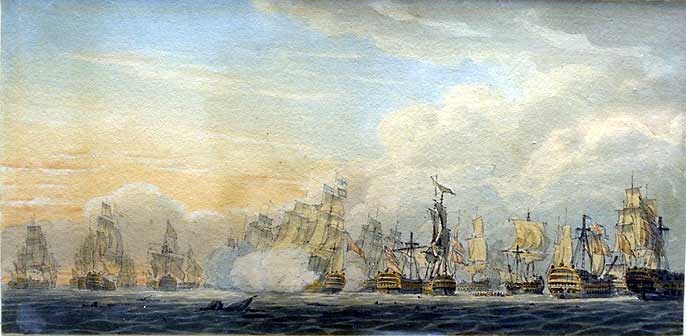
Defeat of the Spanish Fleet, 14 February 1797 Robert Cleveley ( English 1747 -1809) Water-colour 4 in x 8 in Marineart Gallery, New York |
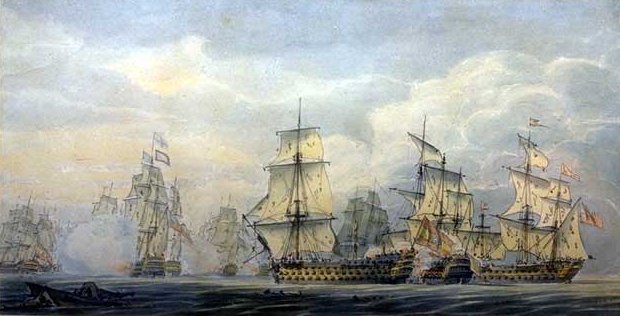
HMS Victory Engaging the Spanish Ship 'Prince of Asturias' off Cape St. Vincent, 1797 Robert Cleveley ( English 1747 -1809) Water-colour 4 in x 8 in Marineart Gallery, New York |
The information on this page is reproduced here with the kind permission of Michael Imig for educational purposes. © Michael Imig, hauxe@erols.com Visit his web site, The Era of the Spanish Galleons
Carracks differed from galleons in that they were still primarily medieval ships built with an emphasis on winning a medieval style battle. The design emphasis was not on sailing qualities and artillery capacity, but with building a ship resistant to enemy boarding parties. (To a lesser extent this is true of the galleon as well and contributed to its eventual demise as a ship design) To repel boarders the aft and forecastles were built up as towering fortresses bristling with archery or gun slits. Although guns are recorded as being in use on some European ships as early as 1337, they did not have any real affect on warfare for nearly 150 years. Early guns were of small calibre, slow to reload, and unreliable in battle.
Caravels were valued for their speed and relative ease of sailing in
contrary winds. Prior to the development of the galleon they were the mainstays
of Spanish shipping. However their small size limited the cargo capacity
of the hull and they gradually disappeared in the late 16th century.
The peak of the caravel was the period from the 1430s to the 1530s when all of Europe, not just Spain and Portugal, made use of them. By this time many caravels were 100--200 tons in size, although this was still quite small in comparison to the average 400 or 500 ton galleon that was to dominate the seas in later decades. The caravels of this time were often square-rigged on the fore and main masts, although the lateen rig was kept for the mizzen. The most famous caravels are the Nina and the Pinta, which sailed with Columbus on his maiden voyage to the New World.
|
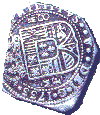 Silver
- Mines were worked in Taxco, Zultepec, Pachuca, Zacatecas, Vetagrande,
San Luis Potosi, Sombrerete, and Guanajuato by 1558 alone. During the two
ensuing centuries mines were worked over much of modern South and Central
America, but the richest deposits seem to have been in Peru and Mexico. Silver
- Mines were worked in Taxco, Zultepec, Pachuca, Zacatecas, Vetagrande,
San Luis Potosi, Sombrerete, and Guanajuato by 1558 alone. During the two
ensuing centuries mines were worked over much of modern South and Central
America, but the richest deposits seem to have been in Peru and Mexico.
Silver was mined in huge quantities, by some estimates at a ratio
of ten to one compared to gold. Aside from being melted down and shipped
to Spain, silver was also used by the several mints in the New World. Denominations
of eight, four, two, one, and one half reales were all struck. The eight-reale
coin, known by much of the world as the “piece-of-eight”, was the common
denomination of economic transactions in the New World. The piece-of-eight
is about an ounce (approximately 29 grams) of silver.
Gold coins were not minted in the New World until 1679, when a mint
was established in Mexico City. Coins were struck in denominations of eight,
four, two, and one escudos. The eight-escudo coin is commonly called the
“doubloon”.
Background Sources: Treasure of the Atocha, R. Duncan Mathewson III, E.P. Dutton, NY,
1986
The Funnel Of Gold, Mendel Peterson, Little Brown & Co., Boston,
1975 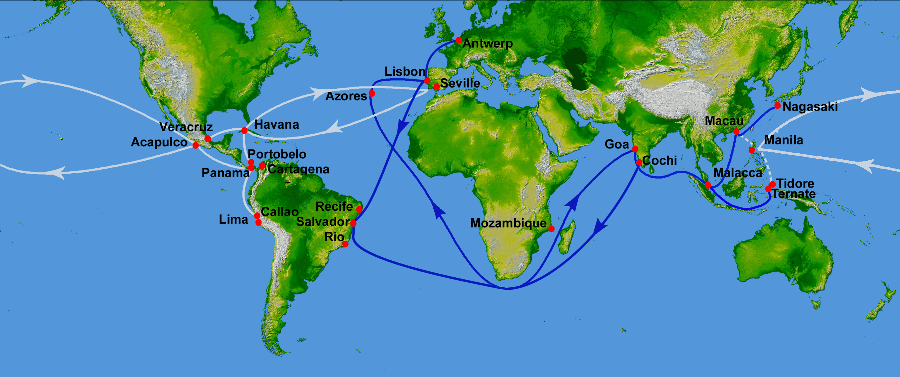 Spanish
galleon routes (white): West Indies or trans-atlantic route begun in
1492, Manila galleon or trans-pacific route begun in 1565. (Blue:
Portuguese routes, operational from 1498 to 1640) Credit: NASA/JPL/NIMA derivative work: Uxbona
Map showing main Portuguese (blue) and Spanish (white) oceanic trade routes in the 16th century, as a result of the exploration during the Age of Discovery. Showing the Spanish colonial Manila-Acapulco Galleons route (1565-1815) between the Viceroyalty of New Spain (México) and the Spanish East Indies (Philippines), using the ports of Acapulco and Cavite. PIA03395: World in Mercator Projection, Shaded Relief and Colored Height 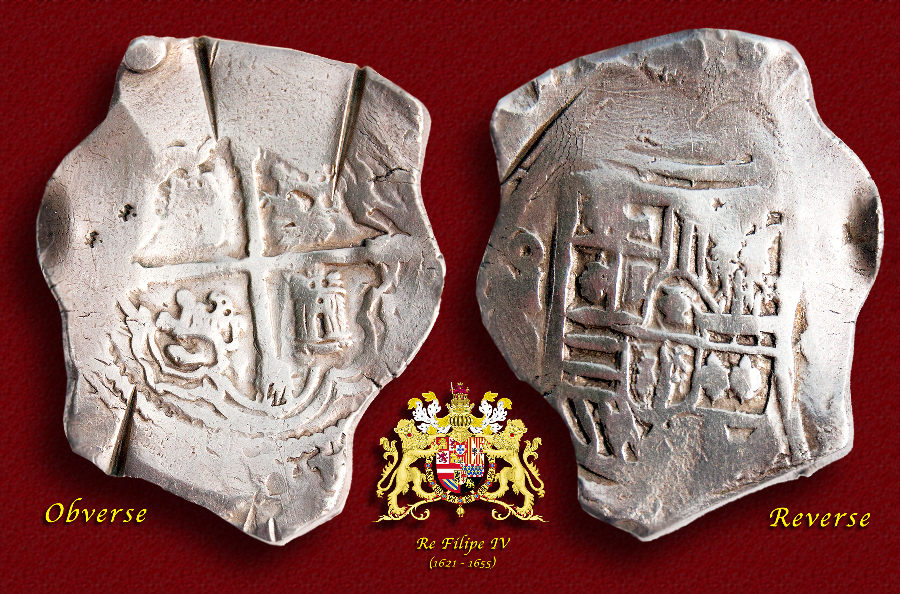 A silver 8-Reales (Peso) coin minted in México (1621-65). Credit: Centpacrr Mint mark17th Century
"Spanish Treasure" "Shield Type" Silver 8-Reales (Peso) Cob
("Macuquina") Coin marked with Spanish Royal Coat of Arms of Filipe IV
(1621-1665) (illustrated) Minted in México City (Mint mark: "M" with
small "o" above located to left of the shield of Filipe IV on reverse).
43mm x 37mm (irregular), 26.658 gm (0.941 oz) [Note: The legal weight
for this denomination was 27.468 gm (0.970 oz); this coin is 0.810 gm
(0.029 oz) short of that.] Fineness: 930.5.
 English ships and the Spanish Armada, August 1588 Credit: Unknown 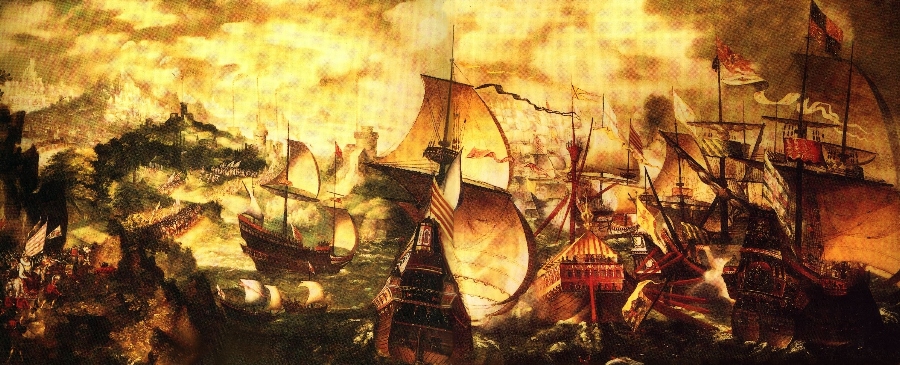 Elizabeth I and the Spanish Armada; the Apothecaries painting,
sometimes attributed to Nicholas Hilliard. A stylised depiction of key
elements of the Armada story: the alarm beacons, Queen Elizabeth at
Tilbury, and the sea battle at Gravelines. Credit: Nicholas Hilliard
Elizabeth I and the Spanish
Armada, an unsigned painting mistakenly attributed to Nicholas Hilliard,
oil on canvas, 121.3 × 284.5 cm (47¾ × 112 in). Held by the Worshipful
Society of Apothecaries of London. The painting presents a stylized
account of the battle of Gravelines between the Spanish Armada and the
English fleet, including the beacons, Elizabeth's address at Tilbury,
and the battle itself in a single montage on three jointed pieces of
fine tabby-weave linen. The smalt used would have once made the sky
bright blue but it and other pigments in the work have discolored over
time. Mainstream historians consider the red and yellow flags simply
Spanish, although some Catalan historians consider them local.
|

{Cannon from the Mary Rose} Firing A Gun Here is a summary of the steps involved in firing a muzzle loading cannon: 1. Insert a charge of gunpowder into the barrel with a gun ladle
Size And Weight Of The Guns The war galleons of the era carried anywhere from 20 to 50 guns forged of iron or brass. Brass was preferred since it did not rust easily, but was far more expensive. On the whole, iron guns were predominant. The calibre of the guns in the era varied widely. Foundries forged everything from 2lb to 50lb guns. (The weight of course is the poundage of the shot, not the gun itself.) On average 24lb guns were carried as the standard broadside on most mid- and larger sized galleons, but again this varied. A broadside might comprise of heavier guns (30lb to 40lbs) fired from lower decks, while lighter guns (15lb to 24lbs) were fired from he upper decks. The heavier guns were placed lower in the ship to improve its stability during rough weather. The table below gives you an idea of weight of the guns themselves.
When you consider that the average galleon might carry 20 to 40 guns of
such weight, plus her crew and other supplies, and sailed under the power
of the wind alone, it's easy to understand why trans-Atlantic journeys
were measured in weeks.
Types Of Shot
The next table gives a listing of the ammunition produced at one Spanish
controlled foundry between 1628 and 1646. The quantities produced
for each respective gun hint at the type of guns most commonly used by
the Spanish military. Of course the numbers make no distinction between
guns used on land and at sea. The three most highly produced weights are
marked with asterisks.
Clearly the 24lb and 16lb guns were prevalent at the time.( Note that due to a lack of internal gun foundries, most Spanish cannons were produced either in Italy or the Spanish Netherlands. But much of the shot was forged in Spain. More information on this in page two.) Smaller Guns & Alternative Shot
Among the other types of shot used by galleons were bar shot and chain shot. These elongated projectiles were used to wreak damage on enemy rigging and sails, and were more effective than ordinary ball shot as an anti-personnel device. A riskier type of shot, known as an "incendiary shot", was a ball with spikes on either end wrapped in tar soaked rope. Ideally flaming ball would lodge in the dry wood of the enemy's hull and set the ship ablaze. But large quantities of flammable ammunition are a liability themselves in battle since a stray spark can send a ship up in flames, and Spanish captains were no doubt wary of its use. Finally some ships carried high-calibre snub nosed weapons known
in that era as mortars. These devices, often firing shot from 30 to 60lbs,
could devastate an enemy vessel with a few short broadsides. What they
had in power, however, they lacked in accuracy, and beyond short range
most mortars were useless. Gun Crews In battle each cannon might have a 2 to 8 man crew, depending on the size of the gun. The heavier weapons needed more manpower to run out after reloading. The length between shots might be as much as three or four minutes, but this varied greatly with the skill of the crew. Between shots the barrel had to be "swabbed" thoroughly with a sponge before the next powder charge was inserted. (If any flaming bits of debris from the previous shot remained there might be a very unpleasant explosion.) Accidents were not uncommon in this era and a disciplined gun crew was better than a recklessly hasty (and no doubt short-lived) gun crew. |
|
The Spanish Seaman's Plight Spain did not generally regard itself as a maritime nation in the 16th and 17th centuries, even though control of the seas was crucial to the protection of its empire. Similar to France, or Germany in later centuries, Spanish power was based on its army—which was second to none in Europe. Unlike mariners in England, Holland, or Portugal, a Spanish mariner suffered from a lack of prestige in his country. The best and brightest military minds went into the Army. Aside from accounts written at the time, one can find evidence of this from two important examples: Spanish Treasure Fleets were often commanded by “admirals” whose military experience was primarily land-based. (The Spanish King himself appointed these men.) Sea-going experience was helpful in obtaining such a post, but few career mariners ever commanded a treasure fleet. The Spanish were discontent to put the onboard companies of troops under the command of sea captains. So they were commanded by an infantry captain and the Spanish galleons thus had a divided chain of command. That is not to say that Spain did not produce some great seamen. But Spain’s predominantly land-based military philosophy was to heavily influence the way it waged war at sea. Spanish Naval Tactics The key tactic of the Spanish navy was to close quickly on the opponents, board their vessels, and attempt to overwhelm them with infantry in hand-to-hand combat. The purpose of the gunnery was to weaken the enemy’s resolve with a powerful broadside at point blank range just prior to boarding. On the other hand the English navy, for example, pursued a strategy of standing off from the enemy and firing their longer range more accurate cannons at a distance. These conflicting strategies obviously favored the combatant who had the quicker, more maneuverable ship since he could determine the strategy. Unfortunately for the Spanish, their galleon design was neither speedy nor maneuverable. In large part this is why the Spanish were at a disadvantage when they sent their powerful Armada against England in 1588.
Deficiencies in Spanish Cannon Shot & Carriages Another problem for the Spanish, which has come to light in recent years, is the quality of shot used in their gunnery. Hints that there were problems can be found in following historical accounts:
Spain and England fought for thirty years in the late 16th and early 17th centuries, but during that time there is not one recorded instance of an English ship being sunk by Spanish gunnery. (Although a good many were captured.) In part this may reflect the Spanish strategy of avoiding prolonged artillery engagements, but that doesn’t seem to be the only reason since there were a number of long, long duels exchanging broadside after broadside. Historical and archeological studies suggest that much of the shot the Spanish used during the era was of poor quality. (For a detailed account see the book Full Fathom Five, Colin Martin, The Viking Press, New York, 1975). Spanish iron smelting foundries produced work that was inferior to most of the foundries in Europe at that time. Principally this was due to their practice of “quenching” or cooling down the shot immediately after casting it. The result was a brittle cannon ball that cracked upon firing and disintegrated upon impact. Another point to note is the Spanish often mounted their shipboard guns on the same type of two wheel carriage the gun would use if it were a piece of field artillery. This seriously limited the accuracy of such weapons because it limited the ability for their aim to be adjusted to the right or left. Infantry Weapons and Firearms The principal weapon of the seaborne Spanish infantryman at sea was
his sword—usually a rapier. Other weapons included the pike, cutlass, and
dagger.
© Michael Imig, hauxe@erols.com Visit his web site The Era of the Spanish Galleons |

Webpage © 1995-2017 Isle of Standauffish